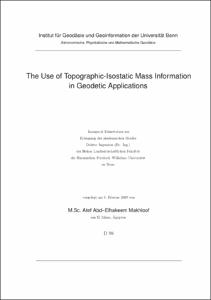The Use of Topographic-Isostatic Mass Information in Geodetic Applications

The Use of Topographic-Isostatic Mass Information in Geodetic Applications

| dc.contributor.advisor | Ilk, Karl-Heinz | |
| dc.contributor.author | Makhloof, Atef Abd-Elhakeem | |
| dc.date.accessioned | 2020-04-09T07:08:00Z | |
| dc.date.available | 2020-04-09T07:08:00Z | |
| dc.date.issued | 2007 | |
| dc.identifier.uri | https://hdl.handle.net/20.500.11811/2706 | |
| dc.description.abstract | The gravity field effects of the topographic-isostatic masses represent an important information of the high-frequent part of the gravity field. In this work the physical-mathematical basics of the classical topographic-isostatic models are presented. These models are formulated mathematically with the emphasis on a spherical approximation from the modelling point of view and on the observables of airborne gravimetry but also of the modern satellite techniques from the application point of view. Besides the representation of the topographic-isostatic mass effects by volume integrals, discretized by spherical volume elements, the representations by series of spherical harmonics and space localizing base functions are considered. Detailed formulae are presented for the direct and secondary indirect topographical effect as well as for the primary indirect topographical effect in the geoid heights for the different representations. Finally, extended test computations give an impression of the size and distribution of the various effects for regional and global test areas with different resolutions of the topography. | |
| dc.description.abstract | Die Nutzung von Topographisch-Isostatischen Masseninformationen in geodätischen Anwendungen Die Gravitationsfeldeffekte der topographisch-isostatischen Massen stellen eine wichtige Information des hochfrequenten Anteils des Gravitationsfeldes dar. In dieser Arbeit werden die physikalisch-mathematischen Grundlagen der klassischen topographisch-isostatischen Modelle dargestellt. Es werden die verschiedenen isostatischen Modelle mathematisch formuliert, wobei auf der Modellbildungsseite der Schwerpunkt auf der sphärischen Approximation liegt und von den Anwendungen die Beobachtungstypen der Flugzeuggravimetrie und der modernen Satellitenmethoden im Vordergrund stehen. Neben der Darstellung der topographisch-isostatischen Masseneffekte durch sphärische Volumenintegrale, diskretisiert durch sphärische Volumenelemente, werden die Reihendarstellungen nach Kugelflächenfunktionen und nach ortslokalisierenden Basisfunktionen zugrunde gelegt. Detaillierte Formeln werden für den direkten bzw. den sekundären indirekten topographischen Effekt in den Schwerewerten und den primären indirekten Effekt in den Geoidhöhen für die verschiedenen Darstellungen angegeben. Schließlich werden Formeln für die Berechnung der Fernzoneneffekte der topographisch-isostatischen Massen angegeben. Hierzu wird eine von Molodenskii angegebene Methode angewendet, die auf der Kugelfunktionsentwicklung der topographisch-isostatischen Massen beruht. Umfangreiche Rechenbeispiele vermitteln einen Eindruck von der Größe und der Verteilung der verschiedenen Effekte, basierend auf unterschiedlich aufgelösten regionalen und globalen Testgebieten. | |
| dc.language.iso | eng | |
| dc.rights | In Copyright | |
| dc.rights.uri | http://rightsstatements.org/vocab/InC/1.0/ | |
| dc.subject.ddc | 550 Geowissenschaften | |
| dc.title | The Use of Topographic-Isostatic Mass Information in Geodetic Applications | |
| dc.type | Dissertation oder Habilitation | |
| dc.publisher.name | Universitäts- und Landesbibliothek Bonn | |
| dc.publisher.location | Bonn | |
| dc.rights.accessRights | openAccess | |
| dc.identifier.urn | https://nbn-resolving.org/urn:nbn:de:hbz:5N-10248 | |
| ulbbn.pubtype | Erstveröffentlichung | |
| ulbbnediss.affiliation.name | Rheinische Friedrich-Wilhelms-Universität Bonn | |
| ulbbnediss.affiliation.location | Bonn | |
| ulbbnediss.thesis.level | Dissertation | |
| ulbbnediss.dissID | 1024 | |
| ulbbnediss.date.accepted | 13.04.2007 | |
| ulbbnediss.fakultaet | Landwirtschaftliche Fakultät | |
| dc.contributor.coReferee | Witte, Bertold |
Files in this item
This item appears in the following Collection(s)
-
E-Dissertationen (1013)




